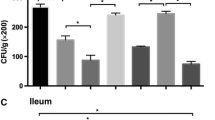Abstract
Iron plays an important role both in bacterial pathogenicity and in host defense mechanisms, which has frequently been underestimated. The primary purpose of this study was to investigate the influence of iron supplementation on the progression of bacterial infection. We used mice as an experimental model to supplement iron after Escherichia coli (E. coli) O157:H7 infection and found that iron supplementation exacerbated clinical symptoms of bacterial infection by increasing mortality and reducing body weight. Iron supplementation promoted the colonization of bacteria and enhanced inflammatory responses by increasing C-reaction protein level and the phagocytic capacity of PBMCs, as well as upregulating the expression of TNF-α and IL-1β in E. coli O157:H7-challenged mice. In vitro cell experiment confirmed that an excess of iron would enhance the growth of E. coli O157:H7 and worsen the outcome of bacterial infection. Therefore, it is certainly plausible that iron supplementation in bacterial infection may worsen rather than improve host outcome.






Similar content being viewed by others
References
Gozzelino R, Arosio P (2016) Iron homeostasis in health and disease. Int J Mol Sci 17:130. https://doi.org/10.3390/ijms17010130
Hamner S, McInnerney K, Williamson K, Franklin MJ, Ford TE (2013) Bile salts affect expression of Escherichia coli O157:H7 genes for virulence and iron acquisition, and promote growth under iron limiting conditions. PLoS One 8:e74647. https://doi.org/10.1371/journal.pone.0074647
Cassat JE, Skaar EP (2013) Iron in infection and immunity. Cell Host Microbe 13:509–519. https://doi.org/10.1016/j.chom.2013.04.010
Weinberg ED (1975) Nutritional immunity: host’s attempt to withhold iron from microbial invaders. JAMA 231:39–41. https://doi.org/10.1001/jama.1975.03240130021018
Jurado RL (1997) Iron, infections, and anemia of inflammation. Clin Infect Dis 25:888–895. https://doi.org/10.1086/515549
Stein J, Hartmann F, Dignass AU (2010) Diagnosis and management of iron deficiency anemia in patients with IBD. Nat Rev Gastroenterol Hepatol 7:599–610. https://doi.org/10.1038/nrgastro.2010.151
Martin J, Radeke HH, Dignass AU, Stein J (2017) Current evaluation and management of anemia in patients with inflammatory bowel disease. Expert Rev Gastroenterol Hepatol 11:19–32. https://doi.org/10.1080/17474124.2017.1263566
Pieracci FM, Barie PS (2005) Iron and the risk of infection. Surg Infect 6:S41–S46. https://doi.org/10.1089/sur.2005.6.s1-41
Moya-Alvarez V, Bodeau-Livinec F, Cot M (2016) Iron and malaria: a dangerous liaison? Nutr Rev 74:612–623. https://doi.org/10.1093/nutrit/nuw021
Sazawal S, Black RE, Ramsan M, Chwaya HM, Stoltzfus RJ, Dutta A, Dhingra U, Kabole I, Deb S, Othman MK, Kabole FM (2006) Effects of routine prophylactic supplementation with iron and folic acid on admission to hospital and mortality in preschool children in a high malaria transmission setting: community-based, randomised, placebo-controlled trial. Lancet 367:133–143. https://doi.org/10.1016/S0140-6736(06)67962-2
Pu Y, Li S, Xiong H, Zhang X, Wang Y, Du H (2018) Iron promotes intestinal development in neonatal piglets. Nutrients 10:E726. https://doi.org/10.3390/nu10060726
Gannon VP, D'Souza S, Graham T, King RK, Rahn K, Read S (1997) Use of the flagellar H7 gene as a target in multiplex PCR assays and improved specificity in identification of enterohemorrhagic Escherichia coli strains. J Clin Microbiol 35:656–662
Khan FA, Fisher MA, Khakoo RA (2007) Association of hemochromatosis with infectious diseases: expanding spectrum. Int J Infect Dis 11:482–487. https://doi.org/10.1016/j.ijid.2007.04.007
Kessler M, Hoen B, Mayeux D, Hestin D, Fontenaille C (1993) Bacteremia in patients on chronic hemodialysis: a multicenter prospective survey. Nephron 64:95–110. https://doi.org/10.1159/000187285
Fernándezreal JM, Manco M (2014) Effects of iron overload on chronic metabolic diseases. Lancet Diabetes Endocrinol 2:513–526. https://doi.org/10.1016/S2213-8587(13)70174-8
Jaeggi T, Kortman GA, Moretti D, Chassard C, Holding P, Dostal A et al (2015) Iron fortification adversely affects the gut microbiome, increases pathogen abundance and induces intestinal inflammation in Kenyan infants. Gut 64:731–742. https://doi.org/10.1136/gutjnl-2014-307720
Constante M, Fragoso G, Calve A, Samba-Mondonga M, Santos MM (2017) Dietary heme induces gut dysbiosis, aggravates colitis, and potentiates the development of adenomas in mice. Front Microbiol 8:1809. https://doi.org/10.3389/fmicb.2017.01809
Frawley ER, Crouch ML, Bingham-Ramos LK, Robbins HF, Wang W, Wright GD et al (2013) Iron and citrate export by a major facilitator superfamily pump regulates metabolism and stress resistance in Salmonella typhimurium. Proc Natl Acad Sci U S A 110:12054–12059. https://doi.org/10.1073/pnas.1218274110
Liu D, Pu Y, Xiong H, Wang Y, Du H (2015) Porcine hepcidin exerts an iron-independent bacteriostatic activity against pathogenic bacteria. Int J Pept Res Ther 21:229–236. https://doi.org/10.1007/s10989-014-9451-7
Wu Y, Potempa LA, El Kebir D, Filep JG (2015) C-reactive protein and inflammation: conformational changes affect function. Biol Chem 396:1181–1197. https://doi.org/10.1515/hsz-2015-0149
Djaldetti M, Bessler H (2014) Mononuclear cells phagocytic activity affects the crosstalk between immune and cancer cells. Biomed Pharmacother 68:679–683. https://doi.org/10.1016/j.biopha.2014.08.004
Yang X, Xiao Z, Liu F, Chen S, Tang W, Zhang D et al (2016) Enterotoxigenic escherichia coli infection alters intestinal immunity in mice. Mol Med Rep 14:825–830. https://doi.org/10.3892/mmr.2016.5302
Ganz T, Nemeth E (2015) Iron homeostasis in host defence and inflammation. Nat Rev Immunol 15:500–510. https://doi.org/10.1038/nri3863
Nemeth E, Tuttle MS, Powelson J, Vaughn MB, Donovan A, Ward DM, Ganz T, Kaplan J (2004) Hepcidin regulates cellular iron efflux by binding to ferroportin and inducing its internalization. Science 306:2090–2093. https://doi.org/10.1126/science.1104742
Gan ZS, Wang QQ, Li JH, Wang XL, Wang YZ, Du HH (2017) Iron reduces M1 macrophage polarization in RAW264.7 macrophages associated with inhibition of STAT1. Mediat Inflamm 2017:8570818. https://doi.org/10.1155/2017/8570818
Soares MP, Weiss G (2015) The iron age of host-microbe interactions. EMBO Rep 16:1482–1500. https://doi.org/10.15252/embr.201540558
Guo BX, Wang QQ, Li JH, Gan ZS, Zhang XF, Wang YZ, Du HH (2017) Lipocalin 2 regulates intestine bacterial survival by interplaying with siderophore in a weaned piglet model of Escherichia coli infection. Oncotarget 8:65386–65396. https://doi.org/10.18632/oncotarget.18528
Funding
This study was supported by the Natural Science Foundation of Zhejiang province of China (No. LR16C170001), National Natural Science Foundation of China (No. 31572411), and National Natural Science Foundation of China (No. 31872363).
Author information
Authors and Affiliations
Corresponding author
Ethics declarations
All experimental procedures were approved by the institutional ethics committee of Zhejiang University.
Conflict of Interest
The authors declare that they have no conflict of interest.
Rights and permissions
About this article
Cite this article
Yu, X., Gan, Z., Wang, Z. et al. Increased Iron Availability Aggravates the Infection of Escherichia coli O157:H7 in Mice. Biol Trace Elem Res 190, 457–465 (2019). https://doi.org/10.1007/s12011-018-1579-4
Received:
Accepted:
Published:
Issue Date:
DOI: https://doi.org/10.1007/s12011-018-1579-4




